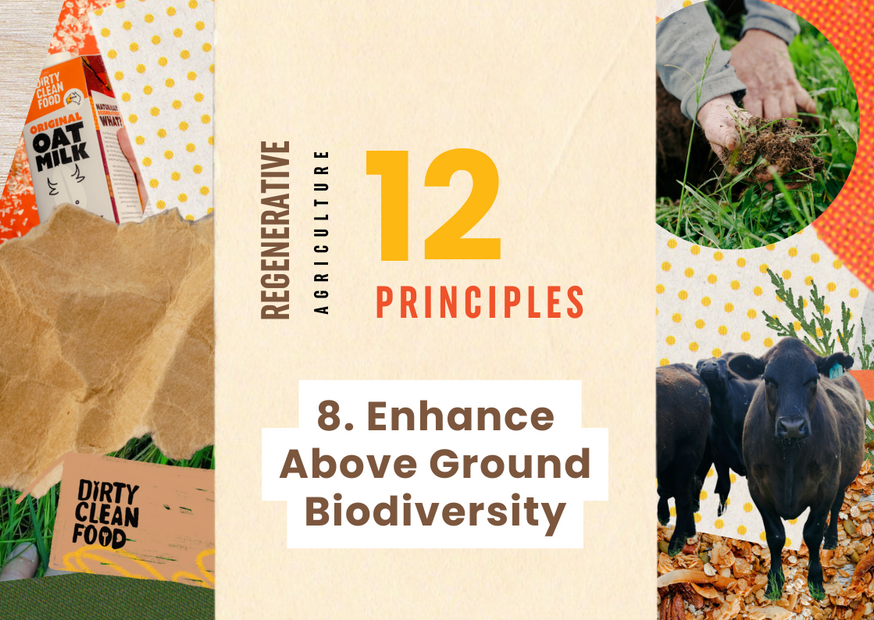
Regen Ag #8-Enhance Above Ground Biodiversity
|
Time to read 2 min
|
Time to read 2 min
Welcome to our 12 Principles of Regenerative Agriculture series- where we define "regen ag" and show you how regenerative farming changes the planet, the system, and our food.
We have differentiated between below and above ground biodiversity here, as our Soil Health principles focus on the underground ecosystem, or below ground biodiversity. Above-ground biodiversity refers to the variety of plant and animal life that exists within the farming ecosystem. It encompasses everything from the crops grown to the insects, birds, and mammals that inhabit the paddocks, any remnant bushland or vegetation and their associated ecosystems.
In conventional farming practices, monocultures dominate, meaning large areas are planted out with a single crop. Some of the issues with planting a monoculture are the increased occurrence of pests and diseases, reliance on synthetic fertiliser, deteriorating soil health, nutrient runoff, and soil compaction. The inputs in these systems also lead to a loss of biodiversity, as it fails to mimic the diverse ecosystems found in nature.
In contrast, regenerative farming seeks to mimic nature by fostering biodiversity above ground. This is achieved through various practices aimed at creating diverse habitats and promoting the health and resilience of ecosystems.
When filling out our regenerative farm plan template, all our farmers list what they are doing under these key areas: corridors and connectivity for biodiversity enhancement (at farm and regional scale), maintaining conservation zones within the farm, committing to no deforestation or clearing, protecting endangered species, and undertaking invasive species management.
Some other ways that improve above ground diversity are planting multi species crops, establishing multi species perennial and annual pastures, working to reduce or eliminate herbicide, pesticide and fungicide use, and working to reduce or eliminate synthetic fertilizer use.
In addition to plants, regenerative farmers also prioritize the health and well-being of above-ground animal species. This may involve creating wildlife corridors to provide habitat and shelter for birds, mammals, and insects. By encouraging the presence of predators such as owls or beneficial insects like ladybugs, farmers can naturally control pest populations without the need for harmful chemicals.
Furthermore, a biodiverse farming system is inherently more resilient to environmental stresses such as extreme weather events or outbreaks of pests or disease. By spreading risk across multiple crops and species, farmers can better withstand fluctuations in market conditions or unforeseen challenges.
Back in 2019, we undertook some revegetation planting across 20 hectares on East Kulinbah, a block of land purchased by Wide Open Agriculture and managed by Stuart McAlpine. These species have grown well and are thriving despite their harsh climate up at Buntine, and the area has seen the growth of many bird, reptile and insect species with the additional 60 species of endemic flowering plants.
For four of our Dirty Clean Food farmers, one of the largest projects they are undertaking that focuses on above ground biodiversity is being part of our Dirty Clean Food Regenerative Farmer Tree Project. This is a carbon project that has the dual benefit of revegetating almost 200 hectares across these four farms. The projects have been designed to link up patches of remnant vegetation, creating wildlife corridors, providing a buffer from prevailing winds, and providing habitat for mammals, birds, reptiles and insects. Some of the progress photos below at Warren Pensini’s farm show how the trees and shrubs have begun to grow and connect up the renmant vegetation.
Beyond the farm gate, enhancing above-ground biodiversity has far-reaching implications for society as a whole. Healthy ecosystems provide essential services such as pollination, water filtration, and carbon sequestration, benefiting not only farmers but entire communities. By supporting regenerative farming practices that prioritize biodiversity, consumers can play a vital role in promoting environmental sustainability and food security.
‘Regenerative agriculture is an ecological approach to farming that allows landscapes to renew themselves.’


